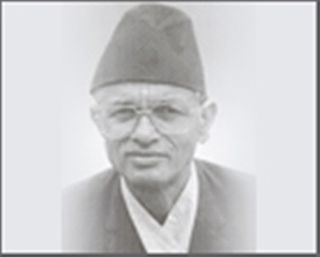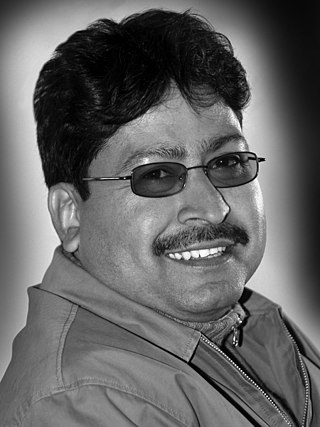Gadul Singh Lama | |
|---|---|
| Born | 15 June 1939 |
| Other names | Sanu Lama |
| Occupation(s) | Fictionist Poet Translator |
| Known for | Nepali literature |
| Parent(s) | Chandraman Ghising Phulmaya Ghising |
| Awards | Padma Shri Sahitya Akademi Award Sikkim Bhanu Puraskar Dr. Shova Kanti Thegim Smrithi Puraskar Madan Byakhanmala Puraskar |
Gadul Singh Lama, popularly known as Sanu Lama, is an Indian fiction writer, poet and translator of Nepali literature.He was an engineer by profession, he has published three short story anthologies and his stories have been translated into English, Hindi, Urdu, Assamese and Oriya languages. [1] He is a recipient of Sahitya Akademi Award (1993), [2] apart from other awards such as Sikkim Bhanu Puraskar, Dr. Shova Kanti Thegim Smrithi Puraskar and Madan Byakhanmala Puraskar. [1] The Government of India awarded him the fourth highest civilian honour of the Padma Shri, in 2005, for his contributions to literature. [3]
Gadul Singh Lama was born on 15 June 1939 in Gangtok, in the Northeast Indian state of Sikkim to Chandraman Ghising and Phulmaya Ghising. [1] After matriculating from the Sir Tyashi Namgyal High School (present day Tashi Namgyal Academy) in 1956 and, getting selected for the education initiative as a part of the 7 Year Development Programme of the government, secured a diploma in Engineering from MBC Institute of Engineering, Burdwan in West Bengal, in 1959. Later, he joined the Sikkim State government service as an engineer and served there for 38 years before superannuating as the Chief Engineer. [1]
Lama started writing from his school days and is reported to have been inspired by one of his teachers, Rashmi Prasad Alley, a writer and one of the pioneers of Nepali education in Sikkim. [4] His first article was published in Changya, a local literary magazine. [5] He published his first short story anthology, Katha Sampad, in 1971, [6] composed of stories such as Swasni Manchey, Khani Tarma Ekdin, Phurbhale Gaun Chadyo and Asinapo Manchey, which has since been selected as a prescribed text for the civil services examination of the Union Public Service Commission. [7] This was followed by Gojika in 1981 and Mrigatrishna in 1993, the latter winning him the Sahitya Akademi Award for the year. [2] He has also written an autobiographical novel, Himalchuli Manitira, a travelogue, Aangan Paratira, a poem anthology, Jahan BagcchaTista Rangit and two translated religious works, Bhagawan Bhiddha Jeewan ra Darshan and Guru Padmasambhava. [1]
Sanu Lama is one of the founders of the Bhartiya Nepali Rashtriya Parishad and served as its secretary on its inception. He is a member of the Editorial Advisory Board of the National Book Trust (NBT) and serves as the general secretary of the Nepali Sahitya Parishad Sikkim, an autonomous literary organization under the Government of Sikkim. [1] He is associated with the Sikkim Akademi, [5] is a former member of the Advisory Board for Nepali literature of the Sahitya Akademi and the president of the Himalayalan Writers' Forum. [6] Besides the 1993 Sahitya Akademi Award, he has received awards such as Sikkim Bhanu Puraskar, Dr. Shova Kanti Thegim Smrithi Puraskar and Madan Byakhanmala Puraskar. [1] The Government of India included him in the 2005 Republic Day Honours list for the civilian honour of the Padma Shri. [3] He lives in Gangtok, the capital of Sikkim, India. [6]

Tashi Namgyal Academy (TNA) is a public school in the Himalayan state of Sikkim in India. It was founded in 1926 by the late Sir Tashi Namgyal, KCSI, KCIE, the 11th consecrated Ruler of Sikkim. It is an autonomous English-medium, co-educational and residential-cum-day school.

Namgyal Institute of Tibetology (NIT) is a Tibet museum in Gangtok, Sikkim, India, named after the 11th Chogyal of Sikkim, Sir Tashi Namgyal. The institute employs researchers and one of its new research programs is a project which seeks to document the social history of Sikkim's approximated 60 monasteries and record this on a computer. Another project seeks to digitize and document old and rare photographs of Sikkim for knowledge distribution. Khempo Dhazar served as head of the Sheda, a Nyingma college attached to the Institute, for six years.
Rajendra Bhandari is an Indian Nepali-language poet and academic at the Sikkim Government College in Gangtok.

Nepali literature refers to literature written in the Nepali language. The Nepali language has been the national language of Nepal since 1958.

Mahananda Poudyal was an Indian writer, teacher, social worker and political thinker.
Hari Prasad Gorkha Rai was a well-known Indian Nagaland-based Nepali language writer. he was long associated, along with other writers at the time, with two major literary organizations Pashupati Sangh (1929) and Tarun Sangh (1930).
Shanti Thatal is an Indian music composer and singer,, known for her works in Nepali film industry. She has more than 200 songs to her credit, including music for several Nepali films. She is the first female music composer of the Nepali film industry.

Lil Bahadur Chettri is an Nepali Indian writer in the Nepali language from Assam, India. He is a recipient of Sahitya Academy Award for his book Brahmaputrako Chheu Chhau. His other book Basain is a story of poor villagers who undergo suffering due to the exploitation of the feudal and so-called upper class of the society. It is included in the curriculum of Tribhuvan University, Nepal. In 2016, he was honoured with Jagadamba Shree Purasakar for his contribution to the Nepali literature and language. In 2020, Government of India awarded him Padmashri, the fourth highest civilian award of India for his contribution in literature and education.
Nepali Sahitya Parishad is a Literary organisation of Nepali language and literature in Sikkim which was established in the year 1981. The organisation mainly engaged in publication and promotion of literary dialogue and ceaselessly endeavored in promoting good taste and healthy reading habits to the like minded people, and groups through seminars, lectures, symposia, discussions, readings and performances, to increase the pace of mutual translations through workshops and individual assignments and to develop a serious literary culture through the publications of journals, monographs, individual creative works of every genre, anthologies, encyclopedias, dictionaries, bibliographies, who's who of writers and histories of literature. The head office of same is located at Jeewan Theeng Marg, Development Area, Gangtok, Sikkim 737101.
Kumar Pradhan was an Indian historian and writer whose research interests include the History of the Eastern Himalayas, Genealogical studies and the Nepali literature. Pradhan has also edited and written a number of literary journals and anthologies and published learned articles in Nepali. He was the chief editor of Sunchari Samachar and other prominent Nepali newspapers.
Kedar Nath Gurung is an Indian educationist and writer of Nepalese literature, known for his satirical expressions. He was honored by the Government of India, in 2012, with the fourth highest Indian civilian award of Padma Shri.
Nirmal Chandra Sinha (1911–1997) was an Indian tibetologist, author, the founder director of Sikkim Research Institute of Tibetology (SIRT), presently known as the Namgyal Institute of Tibetology, Deorali near Gangtok. He was known for his contributions to Buddhism and the documentation of the history of Tibet and other states of Central Asia. He was honoured by the Government of India in 1971 with Padma Shri, the fourth highest Indian civilian award.
Leeladhar Jagudi is an Indian teacher, journalist and poet of Hindi literature. He is the author of several poetry anthologies including Natak Jari Hai and Shankha Mukhi Shikharon Par and is a recipient of the Sahitya Akademi Award, for his 1997 anthology, Anubhav Ke Aakash Mein Chand. The Government of India awarded him the fourth highest civilian honour of the Padma Shri, in 2004, for his contributions to Hindi literature.

Tulsiram Sharma 'Kashyap' was an Indian writer and politician in the Nepali language from Sikkim, India. He is a recipient of Sahitya Academy Award in Nepali for his poetry Aama in 1990. He is the second generation writers of modern era of Nepali literature who has contributed to all genres of literature.
Bhim Prasad Dahal was an Indian politician and writer who was a leader of Sikkim Democratic Front. Dahal served as member of the Lok Sabha representing Sikkim. He was elected to the 11th, 12th and 13th Lok Sabha.

Nayan Raj Pandey is a Nepali writer and screenwriter. He writes stories and novels, as well as screenplays for Nepali cinema. He is known for his representation of contemporary Nepalese society in his novels, presented in a figurative style. He received the Padmashree Sahitya Puraskar for his autobiographical book Yaar in 2017. Ulaar, Loo, Ghamkiri, and Sallipir are Pandey’s popular novels.
Kashiraj Pradhan popularly known as Kashi Babu was an Indian pre-merger politician and journalist in Sikkim. He was the President of Sikkim State Congress party, a member of the Sikkim State Council and Executive Council of Sikkim serving multiple terms in office. Known as the Father of Sikkimese journalism, he was the founder and publisher of Sikkim’s first news magazine Kanchenjunga.

Chandra Das Rai popularly known as C.D Rai was a politician of pre merger Sikkim, bureaucrat and former journalist. He was a senior leader in Sikkim State Congress.

Song of the Soil is a 2019 Nepali novel by Chuden Kabimo. The novel is based on the Gorkhaland movement revolution that took place during 1980s in the northern part of West Bengal. The Nepali edition of the novel was initially published in 2019 by FinePrint Publication in Nepal and Sambodhan Publication in India.

Jahan Bagcha Teesta Rangeet is a song that serves as the de facto state song for Sikkim, India.